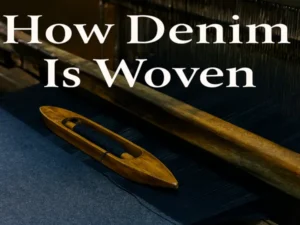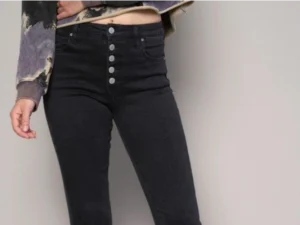Denim fabric is a versatile and timeless textile that has played a significant role in the fashion industry for centuries. But how denim fabric is made? This is a question that cannot be answered by every denim fan.
In the following paragraphs, we are going to learn the first two steps of how denim is made. From the cultivation of high-quality cotton to the yarn’s knowledge to make denim. We explore each step of the process, uncovering the techniques and practices involved.
Here’s the guide to this article:
- Raw Cotton Selection
- Spinning Cotton into Yarns
- At the End
Raw Cotton Selection and Preparation
The quality of raw cotton greatly influences the final denim fabric’s characteristics, such as strength, softness, and dye absorption. Premium quality cotton fibers provide a solid foundation for superior denim production. Here are the factors to consider when selecting raw cotton:
- Fiber length: Longer fibers result in stronger and smoother yarns.
- Fiber strength: High tensile strength ensures better yarn integrity.
- Fiber fineness: Fine fibers contribute to softer denim with excellent drape.
- Fiber maturity: Fully matured fibers possess optimal dye absorption properties.
After we choose the most desired cotton, we will take the raw cotton to the next step: Cotton Ginning.
Cotton ginning is the method used to separate cotton lint from the seeds. This process is critical to ensure the purity of the cotton fiber, eliminating impurities that could affect the yarn and fabric quality.
- Importance of removing impurities and seeds from cotton
Improving fiber quality: Removing impurities like leaves, stems, and dirt allows for cleaner, more uniform fibers.
Enhancing yarn and fabric quality: Eliminating seeds ensures the absence of hard, abrasive particles that could damage the machinery or affect the fabric’s texture.
- Different types of ginning machines
Saw ginning: Traditional method involving saw-toothed rollers that separate the lint from seeds.
Roller ginning: Modern, more efficient method that utilizes gentle, rotating brushes to remove fibers from seeds.
- Practical examples of efficient ginning techniques
Roller ginning with pneumatic cleaning: This method utilizes controlled airflow to minimize fiber damage and effectively remove impurities.
Advanced optical sorting: Optical sensors are used to detect and remove any remaining contaminants, ensuring the utmost purity of the cotton fiber.

- Fiber Preparatory Processes
- Blow-room process:
Opening and cleaning cotton fibers The blow-room process involves opening compressed cotton bales, cleaning them, and separating the fibers. This prepares the cotton fibers for subsequent stages.
- Carding:
Aligning and blending cotton fibers Carding aligns the fibers in a parallel orientation, removing any remaining impurities. It also blends different cotton fiber lots to maintain uniformity and enhance yarn quality.
- Combing (optional):
Removal of short fibers and impurities Combing, an optional step, further refines the fibers by removing shorter fibers, and residual impurities, and achieving overall fiber alignment. Combed cotton produces smoother, finer yarns ideal for premium denim.
- Practical examples of modern fiber preparation methods
Advanced carding machines: Modern carding machines employ precise control systems and air currents to ensure consistent, high-quality fiber alignment and cleaning.
Combing machinery: Automated combing machines eliminate short fibers and impurities, maximizing yarn smoothness and strength.
Spinning Cotton into Yarns
The spinning process is where the transformation from cotton fibers to yarn truly takes place. Spinning involves stretching and twisting the fibers to create a continuous, strong thread. One of the most common spinning techniques used in denim fabric production is ring spinning. This method involves feeding the carded sliver through a series of rollers while simultaneously twisting and winding the yarn onto a bobbin.
On the other hand, open-end spinning offers a more efficient way to produce yarns. It involves directly pulling the fibers into the spinning rotor, where they are twisted and compacted into yarn. Although this process is quicker and less expensive, the resulting yarn is typically coarser compared to ring-spun yarn.
Both ring spinning and open-end spinning have their advantages and disadvantages. Ring-spun yarns are known for their softer feel and strength, making them ideal for high-quality denim fabrics. Open-end spun yarns, on the other hand, are more cost-effective and are often used in denim that prioritizes durability.

- Strengthening Yarns for Denim Production
During denim production, the yarns need to be strengthened to withstand the rigors of wear. Ply twisting, a process that involves twisting multiple yarns together, and doubling, which combines two or more single yarns, are commonly used to enhance the strength of denim yarns. The resulting ply or doubled yarns are more robust and resistant to breakage, contributing to the overall durability of the denim fabric.
What is Yarn Twist? Yarn twist refers to the spiral direction of the fibers in a yarn. It is the result of twisting fiber strands together during the spinning process. Yarn twists can be categorized into two types: S-twist and Z-twist. In S-twist yarn, the fibers spiral in a counterclockwise direction, while in Z-twist yarn, the spiral is in a clockwise direction. These twists are crucial as they affect the final properties and appearance of the denim fabric.
The Relationship Between Yarn Twist and Denim Characteristics: Yarn twist plays a significant role in determining the strength, durability, and appearance of denim fabric.
When it comes to fabric strength and durability, the yarn twist is a critical factor to consider. Higher twist denim fabrics tend to have increased strength due to the tightness and compactness of the twisted yarns. This is especially beneficial in workwear or heavy-duty denim applications. On the other hand, lower-twist denim fabrics offer a softer, more comfortable feel, making them popular for casual and fashion-oriented denim products.
How does Yarn Twist Affect the Fabric’s Appearance?
Similarly, yarn twist affects fabric appearance. S-twist yarns play a vital role in creating a more prominent twill weave in denim, giving it a characteristic diagonal pattern. This twill effect is a defining feature of denim fabric. Conversely, Z-twist yarns contribute to a smoother fabric surface, creating a more uniform appearance.
Yarn Twist and Denim Processing Techniques: The choice of yarn twist also influences various denim processing techniques, including dye absorption and denim finishing processes.
In terms of dye absorption, the yarn twist can impact the penetration of the dye into the fabric. S-twist yarns, with their more open structure, allow better dye penetration, resulting in deeper and more vibrant colors. On the other hand, Z-twist yarns create a higher surface density, making them more resistant to dye penetration. This characteristic makes Z-twist yarns ideal for achieving faded and aged denim looks.
Denim finishing processes such as distressing or innovative denim washes can be influenced by yarn twists as well. High-twist yarns are often employed for distressing techniques, as their increased strength withstands the rigorous distressing treatments, creating unique distressed denim effects. Conversely, low-twist yarns are preferred for innovative denim washes, allowing them to easily absorb and retain the desired effects, such as vintage washes or innovative dye treatments.
How to Decide Yarn Twist for Your Fabric?
Practical Considerations for Yarn Twist Selection: Several factors should be taken into consideration when selecting the appropriate yarn twist for denim production.
Firstly, the type and length of fibers used in yarn production significantly impact the yarn twist determination. Different fibers exhibit varying tendencies to twist, which in turn, influence the resulting denim fabric’s characteristics.
Secondly, desired fabric characteristics and preferences also play a crucial role in determining the yarn twist. The specific demands of the garment, such as durability, softness, or a particular aesthetic, will inform the choice of yarn twist.
Evaluating yarn twists in fabric samples is an essential step in the selection process. Assessing fabric strength and durability through testing methods such as tensile strength measurements helps determine the suitability of a particular yarn twist for specific applications. Additionally, examining fabric appearance and texture provides insights into the visual and tactile characteristics that the yarn twist imparts to the denim fabric.
At the End
After reading the information from this article, you are already taking a big step in the denim fabric manufacturing world. Cotton selection is very important and is the key to deciding the quality of the fabric. And the way to turn cotton into yarn also helps decide what kind of fabric effect you are achieving, strong or soft, slub style or without slub, etc. This is just the beginning of how to make denim fabric and the next step we will move deeper into the denim world. Let’s follow Zeva Denim’s steps.
We are a denim fabric manufacturer for more than 10 years and keep our high-level job to produce middle to high-level denim fabric for the world. If you need any professional ideas about how to choose a denim fabric, do not hesitate to check with us. Our products are mainly sold to fabric wholesalers and garment manufacturers all over the world.
Hope you enjoy this article and don’t forget to share your thought with us.
Happy Reading!





